Neptune ♆

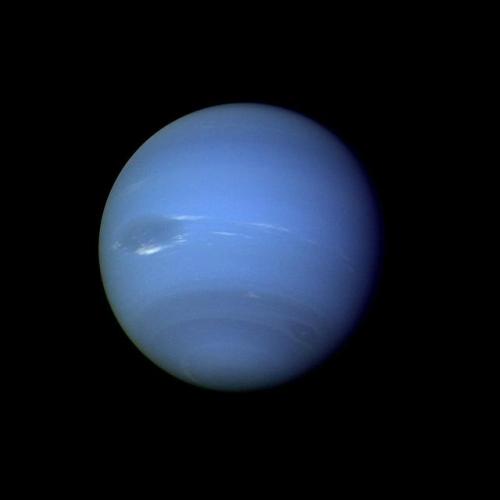
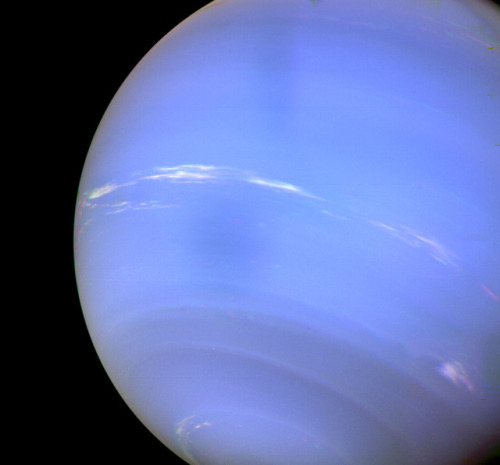
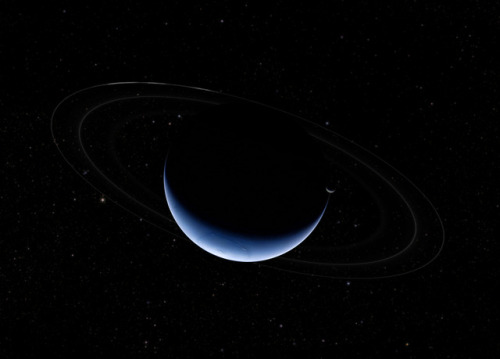
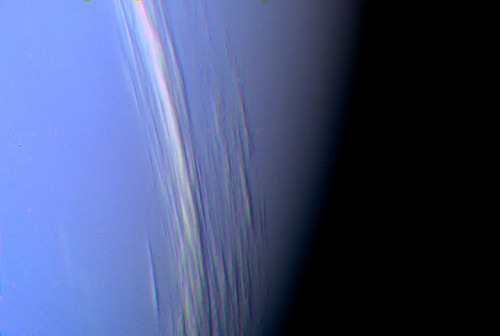
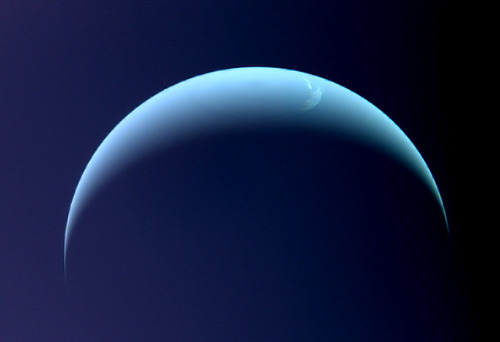
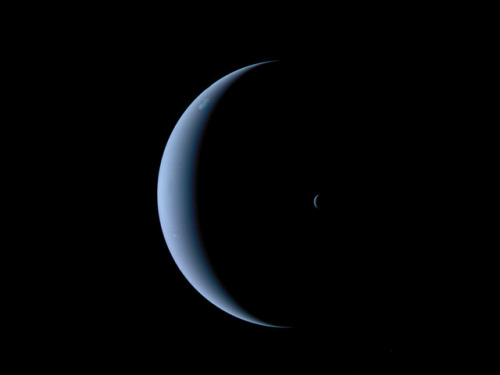
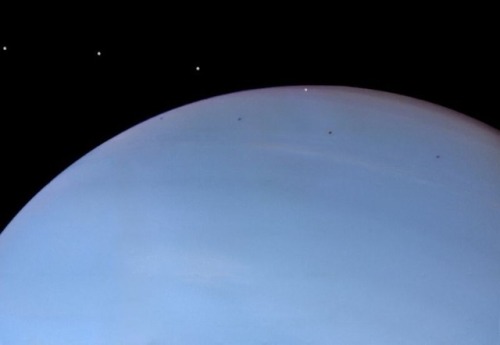
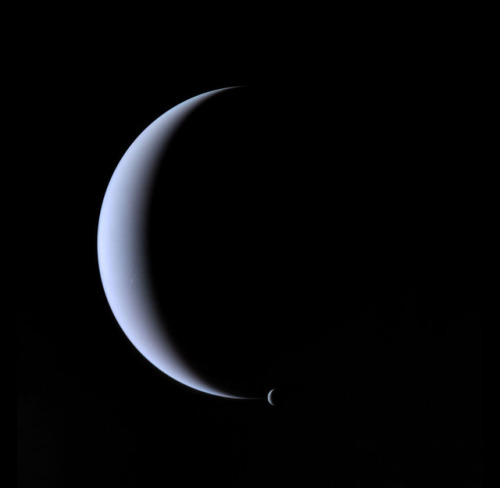
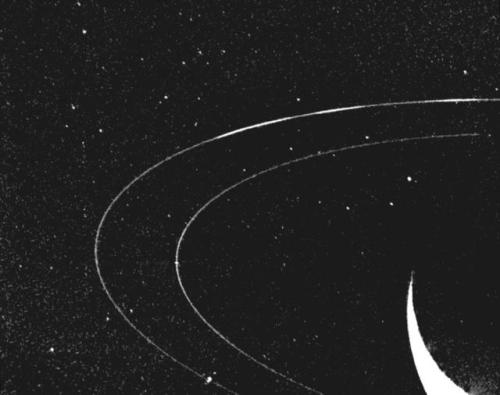
Neptune ♆
On this day in 1846 was discovered the planet Neptune.
The ice giant Neptune was the first planet located through mathematical predictions rather than through regular observations of the sky. (Galileo had recorded it as a fixed star during observations with his small telescope in 1612 and 1613.) When Uranus didn’t travel exactly as astronomers expected it to, a French mathematician, Urbain Joseph Le Verrier, proposed the position and mass of another as yet unknown planet that could cause the observed changes to Uranus’ orbit. After being ignored by French astronomers, Le Verrier sent his predictions to Johann Gottfried Galle at the Berlin Observatory, who found Neptune on his first night of searching in 1846. Seventeen days later, its largest moon, Triton, was also discovered.
Neptune is invisible to the naked eye because of its extreme distance from Earth. Interestingly, the highly eccentric orbit of the dwarf planet Pluto brings Pluto inside Neptune’s orbit for a 20-year period out of every 248 Earth years. Pluto can never crash into Neptune, though, because for every three laps Neptune takes around the Sun, Pluto makes two. This repeating pattern prevents close approaches of the two bodies.
Nearly 4.5 billion kilometers (2.8 billion miles) from the Sun, Neptune orbits the Sun once every 165 years.
Uranus’ blue-green color is also the result of atmospheric methane, but Neptune is a more vivid, brighter blue, so there must be an unknown component that causes the more intense color.
Despite its great distance and low energy input from the Sun, Neptune’s winds can be three times stronger than Jupiter’s and nine times stronger than Earth’s.
Winds on Neptune travel faster than the speed of sound.
In 1989, Voyager 2 tracked a large, oval-shaped, dark storm in Neptune’s southern hemisphere. This “Great Dark Spot” was large enough to contain the entire Earth.
Neptune has five known rings. Voyager 2’s observations confirmed that these unusual rings are not uniform but have four thick regions (clumps of dust) called arcs. The rings are thought to be relatively young and short-lived.
Neptune has 14 known moons, six of which were discovered by Voyager 2.
Triton, Neptune’s largest moon, orbits the planet in the opposite direction compared with the rest of the moons, suggesting that it may have been captured by Neptune in the distant past.
To know more about the planet Neptune click here and here.
Images credit: NASA/JPL- Caltech (some images processed by Kevin M. Gill)
More Posts from Ocrim1967 and Others
5 New Competitions for the Artemis Generation!
A common question we get is, “How can I work with NASA?”
The good news is—just in time for the back-to-school season—we have a slew of newly announced opportunities for citizen scientists and researchers in the academic community to take a shot at winning our prize competitions.
As we plan to land humans on the Moon by 2024 with our upcoming Artemis missions, we are urging students and universities to get involved and offer solutions to the challenges facing our path to the Moon and Mars. Here are five NASA competitions and contests waiting for your ideas on everything from innovative ways to drill for water on other planets to naming our next rover:
1. The BIG Idea Challenge: Studying Dark Regions on the Moon
Before astronauts step on the Moon again, we will study its surface to prepare for landing, living and exploring there. Although it is Earth’s closest neighbor, there is still much to learn about the Moon, particularly in the permanently shadowed regions in and near the polar regions.

Through the annual Breakthrough, Innovative and Game-changing (BIG) Idea Challenge, we’re asking undergraduate and graduate student teams to submit proposals for sample lunar payloads that can demonstrate technology systems needed to explore areas of the Moon that never see the light of day. Teams of up to 20 students and their faculty advisors are invited to propose unique solutions in response to one of the following areas:
• Exploration of permanently shadowed regions in lunar polar regions • Technologies to support in-situ resource utilization in these regions • Capabilities to explore and operate in permanently shadowed regions
Interested teams are encouraged to submit a Notice of Intent by September 27 in order to ensure an adequate number of reviewers and to be invited to participate in a Q&A session with the judges prior to the proposal deadline. Proposal and video submission are due by January 16, 2020.
2. RASC-AL 2020: New Concepts for the Moon and Mars
Although boots on the lunar surface by 2024 is step one in expanding our presence beyond low-Earth orbit, we’re also readying our science, technology and human exploration missions for a future on Mars.
The 2020 Revolutionary Aerospace Systems Concepts – Academic Linkage (RASC-AL) Competition is calling on undergraduate and graduate teams to develop new concepts that leverage innovations for both our Artemis program and future human missions to the Red Planet. This year’s competition branches beyond science and engineering with a theme dedicated to economic analysis of commercial opportunities in deep space.

Competition themes range from expanding on how we use current and future assets in cislunar space to designing systems and architectures for exploring the Moon and Mars. We’re seeking proposals that demonstrate originality and creativity in the areas of engineering and analysis and must address one of the five following themes: a south pole multi-purpose rover, the International Space Station as a Mars mission analog, short surface stay Mars mission, commercial cislunar space development and autonomous utilization and maintenance on the Gateway or Mars-class transportation.
The RASC-AL challenge is open to undergraduate and graduate students majoring in science, technology, engineering, or mathematics at an accredited U.S.-based university. Submissions are due by March 5, 2020 and must include a two-minute video and a detailed seven to nine-page proposal that presents novel and robust applications that address one of the themes and support expanding humanity’s ability to thrive beyond Earth.
3. The Space Robotics Challenge for Autonomous Rovers
Autonomous robots will help future astronauts during long-duration missions to other worlds by performing tedious, repetitive and even strenuous tasks. These robotic helpers will let crews focus on the more meticulous areas of exploring. To help achieve this, our Centennial Challenges initiative, along with Space Center Houston of Texas, opened the second phase of the Space Robotics Challenge. This virtual challenge aims to advance autonomous robotic operations for missions on the surface of distant planets or moons.

This new phase invites competitors 18 and older from the public, industry and academia to develop code for a team of virtual robots that will support a simulated in-situ resource utilization mission—meaning gathering and using materials found locally—on the Moon.
The deadline to submit registration forms is December 20.
4. Moon to Mars Ice & Prospecting Challenge to Design Hardware, Practice Drilling for Water on the Moon and Mars
A key ingredient for our human explorers staying anywhere other than Earth is water. One of the most crucial near-term plans for deep space exploration includes finding and using water to support a sustained presence on our nearest neighbor and on Mars.
To access and extract that water, NASA needs new technologies to mine through various layers of lunar and Martian dirt and into ice deposits we believe are buried beneath the surface. A special edition of the RASC-AL competition, the Moon to Mars Ice and Prospecting Challenge, seeks to advance critical capabilities needed on the surface of the Moon and Mars. The competition, now in its fourth iteration, asks eligible undergraduate and graduate student teams to design and build hardware that can identify, map and drill through a variety of subsurface layers, then extract water from an ice block in a simulated off-world test bed.
Interested teams are asked to submit a project plan detailing their proposed concept’s design and operations by November 14. Up to 10 teams will be selected and receive a development stipend. Over the course of six months teams will build and test their systems in preparation for a head-to-head competition at our Langley Research Center in June 2020.
5. Name the Mars 2020 Rover!
Red rover, red rover, send a name for Mars 2020 right over! We’re recruiting help from K-12 students nationwide to find a name for our next Mars rover mission.
The Mars 2020 rover is a 2,300-pound robotic scientist that will search for signs of past microbial life, characterize the planet’s climate and geology, collect samples for future return to Earth, and pave the way for human exploration of the Red Planet.
K-12 students in U.S. public, private and home schools can enter the Mars 2020 Name the Rover essay contest. One grand prize winner will name the rover and be invited to see the spacecraft launch in July 2020 from Cape Canaveral Air Force Station in Florida. To enter the contest, students must submit by November 1 their proposed rover name and a short essay, no more than 150 words, explaining why their proposed name should be chosen.
Just as the Apollo program inspired innovation in the 1960s and ‘70s, our push to the Moon and Mars is inspiring students—the Artemis generation—to solve the challenges for the next era of space exploration.
For more information on all of our open prizes and challenges, visit: https://www.nasa.gov/solve/explore_opportunities
Make sure to follow us on Tumblr for your regular dose of space: http://nasa.tumblr.com









this cat is so cute
Stellar Winds
Stellar winds are fast moving flows of material (protons, electrons and atoms of heavier metals) that are ejected from stars. These winds are characterised by a continuous outflow of material moving at speeds anywhere between 20 and 2,000 km/s.

In the case of the Sun, the wind ‘blows’ at a speed of 200 to 300 km/s from quiet regions, and 700 km/s from coronal holes and active regions.

The causes, ejection rates and speeds of stellar winds vary with the mass of the star. In relatively cool, low-mass stars such as the Sun, the wind is caused by the extremely high temperature (millions of degrees Kelvin) of the corona.

his high temperature is thought to be the result of interactions between magnetic fields at the star’s surface, and gives the coronal gas sufficient energy to escape the gravitational attraction of the star as a wind. Stars of this type eject only a tiny fraction of their mass per year as a stellar wind (for example, only 1 part in 1014 of the Sun’s mass is ejected in this way each year), but this still represents losses of millions of tonnes of material each second. Even over their entire lifetime, stars like our Sun lose only a tiny fraction of 1% of their mass through stellar winds.

In contrast, hot, massive stars can produce stellar winds a billion times stronger than those of low-mass stars. Over their short lifetimes, they can eject many solar masses (perhaps up to 50% of their initial mass) of material in the form of 2,000 km/sec winds.

These stellar winds are driven directly by the radiation pressure from photons escaping the star. In some cases, high-mass stars can eject virtually all of their outer envelopes in winds. The result is a Wolf-Rayet star.

Stellar winds play an important part in the chemical evolution of the Universe, as they carry dust and metals back into the interstellar medium where they will be incorporated into the next generation of stars.
source (read more) + Wolf–Rayet star
How Do You Solve a Problem Like Dark Energy?

Here’s the deal — the universe is expanding. Not only that, but it’s expanding faster and faster due to the presence of a mysterious substance scientists have named “dark energy.”
But before we get to dark energy, let’s first talk a bit about the expanding cosmos. It started with the big bang — when the universe started expanding from a hot, dense state about 13.8 billion years ago. Our universe has been getting bigger and bigger ever since. Nearly every galaxy we look at is zipping away from us, caught up in that expansion!

The expansion, though, is even weirder than you might imagine. Things aren’t actually moving away from each other. Instead, the space between them is getting larger.
Imagine that you and a friend were standing next to each other. Just standing there, but the floor between you was growing. You two aren’t technically moving, but you see each other moving away. That’s what’s happening with the galaxies (and everything else) in our cosmos … in ALL directions!

Astronomers expected the expansion to slow down over time. Why? In a word: gravity. Anything that has mass or energy has gravity, and gravity tries to pull stuff together. Plus, it works over the longest distances. Even you, reading this, exert a gravitational tug on the farthest galaxy in the universe! It’s a tiny tug, but a tug nonetheless.
As the space between galaxies grows, gravity is trying to tug the galaxies back together — which should slow down the expansion. So, if we measure the distance of faraway galaxies over time, we should be able to detect if the universe’s growth rate slows down.

But in 1998, a group of astronomers measured the distance and velocity of a number of galaxies using bright, exploding stars as their “yardstick.” They found out that the expansion was getting faster.
Not slowing down.
Speeding up.

⬆️ This graphic illustrates the history of our expanding universe. We do see some slowing down of the expansion (the uphill part of the graph, where the roller coaster is slowing down). However, at some point, dark energy overtakes gravity and the expansion speeds up (the downhill on the graph). It’s like our universe is on a giant roller coaster ride, but we’re not sure how steep the hill is!

Other researchers also started looking for signs of accelerated expansion. And they found it — everywhere. They saw it when they looked at individual stars. They saw it in large scale structures of the universe, like galaxies, galaxy groups and clusters. They even saw it when they looked at the cosmic microwave background (that’s what’s in this image), a “baby picture” of the universe from just a few hundred thousand years after the big bang.
If you thought the roller coaster was wild, hold on because things are about to get really weird.
Clearly, we were missing something. Gravity wasn’t the biggest influence on matter and energy across the largest scales of the universe. Something else was. The name we’ve given to that “something else” is dark energy.

We don’t know exactly what dark energy is, and we’ve never detected it directly. But we do know there is a lot of it. A lot. If you summed up all the “stuff” in the universe — normal matter (the stuff we can touch or observe directly), dark matter, and dark energy — dark energy would make up more than two-thirds of what is out there.
That’s a lot of our universe to have escaped detection!
Researchers have come up with a few dark energy possibilities. Einstein discarded an idea from his theory of general relativity about an intrinsic property of space itself. It could be that this bit of theory got dark energy right after all. Perhaps instead there is some strange kind of energy-fluid that fills space. It could even be that we need to tweak Einstein’s theory of gravity to work at the largest scales.
We’ll have to stay tuned as researchers work this out.

Our Wide Field Infrared Survey Telescope (WFIRST) — planned to launch in the mid-2020s — will be helping with the task of unraveling the mystery of dark energy. WFIRST will map the structure and distribution of matter throughout the cosmos and across cosmic time. It will also map the universe’s expansion and study galaxies from when the universe was a wee 2-billion-year-old up to today. Using these new data, researchers will learn more than we’ve ever known about dark energy. Perhaps even cracking open the case!
You can find out more about the history of dark energy and how a number of different pieces of observational evidence led to its discovery in our Cosmic Times series. And keep an eye on WFIRST to see how this mystery unfolds.
Make sure to follow us on Tumblr for your regular dose of space: http://nasa.tumblr.com










Ask Ethan: Is Spacetime Really A Fabric?
“I’d like somebody to finally acknowledge and admit that showing balls on a bed sheet doesn’t cut it as a picture of reality.”
Okay, I admit it: visualizing General Relativity as balls on a bedsheet doesn’t make a whole lot of sense. For one, if this is what gravity is supposed to be, what pulls the balls “down” onto the bedsheet? For another, if space is three dimensional, why are we talking about a 2D “fabric” of space? And for another, why do these lines curve away from the mass, rather than towards it?
It’s true: this visualization of General Relativity is highly flawed. But, believe it or not, all visualizations of General Relativity inherently have similar flaws. The reason is that space itself is not an observable thing! In Einstein’s theory, General Relativity provides the link between the matter and energy in the Universe, which determines the geometric curvature of spacetime, and how the rest of the matter and energy in the Universe moves in response to that. In this Universe, we can only measure matter and energy, not space itself. We can visualize it how we like, but all visualizations are inherently flawed.
Come get the story of how to make as much sense as possible out of the Universe we actually have.


HiPOD (31 August 2018) Dunes in South Xainza Crater
– They look so innocent… (270 km above the surface. Black and white is less than 5 km across; enhanced color is less than 1 km.)
NASA/JPL/University of Arizona
What is Gravitational Lensing?
A gravitational lens is a distribution of matter (such as a cluster of galaxies) between a distant light source and an observer, that is capable of bending the light from the source as the light travels towards the observer. This effect is known as gravitational lensing, and the amount of bending is one of the predictions of Albert Einstein’s general theory of relativity.

This illustration shows how gravitational lensing works. The gravity of a large galaxy cluster is so strong, it bends, brightens and distorts the light of distant galaxies behind it. The scale has been greatly exaggerated; in reality, the distant galaxy is much further away and much smaller. Credit: NASA, ESA, L. Calcada
There are three classes of gravitational lensing:
1° Strong lensing: where there are easily visible distortions such as the formation of Einstein rings, arcs, and multiple images.

Einstein ring. credit: NASA/ESA&Hubble
2° Weak lensing: where the distortions of background sources are much smaller and can only be detected by analyzing large numbers of sources in a statistical way to find coherent distortions of only a few percent. The lensing shows up statistically as a preferred stretching of the background objects perpendicular to the direction to the centre of the lens. By measuring the shapes and orientations of large numbers of distant galaxies, their orientations can be averaged to measure the shear of the lensing field in any region. This, in turn, can be used to reconstruct the mass distribution in the area: in particular, the background distribution of dark matter can be reconstructed. Since galaxies are intrinsically elliptical and the weak gravitational lensing signal is small, a very large number of galaxies must be used in these surveys.

The effects of foreground galaxy cluster mass on background galaxy shapes. The upper left panel shows (projected onto the plane of the sky) the shapes of cluster members (in yellow) and background galaxies (in white), ignoring the effects of weak lensing. The lower right panel shows this same scenario, but includes the effects of lensing. The middle panel shows a 3-d representation of the positions of cluster and source galaxies, relative to the observer. Note that the background galaxies appear stretched tangentially around the cluster.
3° Microlensing: where no distortion in shape can be seen but the amount of light received from a background object changes in time. The lensing object may be stars in the Milky Way in one typical case, with the background source being stars in a remote galaxy, or, in another case, an even more distant quasar. The effect is small, such that (in the case of strong lensing) even a galaxy with a mass more than 100 billion times that of the Sun will produce multiple images separated by only a few arcseconds. Galaxy clusters can produce separations of several arcminutes. In both cases the galaxies and sources are quite distant, many hundreds of megaparsecs away from our Galaxy.
Gravitational lenses act equally on all kinds of electromagnetic radiation, not just visible light. Weak lensing effects are being studied for the cosmic microwave background as well as galaxy surveys. Strong lenses have been observed in radio and x-ray regimes as well. If a strong lens produces multiple images, there will be a relative time delay between two paths: that is, in one image the lensed object will be observed before the other image.

As an exoplanet passes in front of a more distant star, its gravity causes the trajectory of the starlight to bend, and in some cases results in a brief brightening of the background star as seen by a telescope. The artistic concept illustrates this effect. This phenomenon of gravitational microlensing enables scientists to search for exoplanets that are too distant and dark to detect any other way.Credits: NASA Ames/JPL-Caltech/T. Pyle
Explanation in terms of space–time curvature

Simulated gravitational lensing by black hole by: Earther
In general relativity, light follows the curvature of spacetime, hence when light passes around a massive object, it is bent. This means that the light from an object on the other side will be bent towards an observer’s eye, just like an ordinary lens. In General Relativity the speed of light depends on the gravitational potential (aka the metric) and this bending can be viewed as a consequence of the light traveling along a gradient in light speed. Light rays are the boundary between the future, the spacelike, and the past regions. The gravitational attraction can be viewed as the motion of undisturbed objects in a background curved geometry or alternatively as the response of objects to a force in a flat geometry.

A galaxy perfectly aligned with a supernova (supernova PS1-10afx) acts as a cosmic magnifying glass, making it appear 100 billion times more dazzling than our Sun. Image credit: Anupreeta More/Kavli IPMU.
To learn more, click here.
50 Reasons It's Time For Smartphones In Every Classroom

“There are many ways to use a smartphone in the classroom, but it continues to be a touchy subject. Privacy, equity, bandwidth, lesson design, classroom management, theft, bullying, and scores of other legitimate concerns continue to cloud education’s thinking about how to meaningfully integrate technology in the learning process.”
Earth: Our Oasis in Space

Earth: It’s our oasis in space, the one place we know that harbors life. That makes it a weird place – so far, we haven’t found life anywhere else in the solar system…or beyond. We study our home planet and its delicate balance of water, atmosphere and comfortable temperatures from space, the air, the ocean and the ground.

To celebrate our home, we want to see what you love about our planet. Share a picture, or several, of Earth with #PictureEarth on social media. In return, we’ll share some of our best views of our home, like this one taken from a million miles away by the Earth Polychromatic Imaging Camera (yes, it’s EPIC).

From a DC-8 research plane flying just 1500 feet above Antarctic sea ice, we saw a massive iceberg newly calved off Pine Island Glacier. This is one in a series of large icebergs Pine Island has lost in the last few years – the glacier is one of the fastest melting in Antarctica.

It’s not just planes. We also saw the giant iceberg, known as B-46, from space. Landsat 8 tracked B-46’s progress after it broke off from Pine Island Glacier and began the journey northward, where it began to break apart and melt into the ocean.

Speaking of change, we’ve been launching Earth-observing satellites since 1958. In that time, we’ve seen some major changes. Cutting through soft, sandy soil on its journey to the Bay of Bengal, the Padma River in Bangladesh dances across the landscape in this time-lapse of 30 years’ worth of Landsat images.

Our space-based view of Earth helps us track other natural activities, too. With both a daytime and nighttime view, the Aqua satellite and the Suomi NPP satellite helped us see where wildfires were burning in California, while also tracking burn scars and smoke plumes..

Astronauts have an out-of-this-world view of Earth, literally. A camera mounted on the International Space Station captured this image of Hurricane Florence after it intensified to Category 4.

It’s not just missions studying Earth that capture views of our home planet. Parker Solar Probe turned back and looked at our home planet while en route to the Sun. Earth is the bright, round object.
Want to learn more about our home planet? Check out our third episode of NASA Science Live where we talked about Earth and what makes it so weird.
Make sure to follow us on Tumblr for your regular dose of space: http://nasa.tumblr.com




Ψ ♥ For more interesting psychology posts like this, follow @mypsychology ♥ Ψ
-
 1rh2nxoz reblogged this · 3 months ago
1rh2nxoz reblogged this · 3 months ago -
 i-iii-iii-vii liked this · 4 months ago
i-iii-iii-vii liked this · 4 months ago -
 stellarseeming reblogged this · 8 months ago
stellarseeming reblogged this · 8 months ago -
 stellarseeming liked this · 8 months ago
stellarseeming liked this · 8 months ago -
 cernunnos1990 reblogged this · 10 months ago
cernunnos1990 reblogged this · 10 months ago -
 cernunnos1990 liked this · 10 months ago
cernunnos1990 liked this · 10 months ago -
 allarounddivinity reblogged this · 11 months ago
allarounddivinity reblogged this · 11 months ago -
 sailorviii liked this · 11 months ago
sailorviii liked this · 11 months ago -
 yassygoth liked this · 1 year ago
yassygoth liked this · 1 year ago -
 demichrising liked this · 1 year ago
demichrising liked this · 1 year ago -
 spiritualitysalad liked this · 1 year ago
spiritualitysalad liked this · 1 year ago -
 ravexandxlust liked this · 1 year ago
ravexandxlust liked this · 1 year ago -
 starryfishbonesoup liked this · 1 year ago
starryfishbonesoup liked this · 1 year ago -
 spacetism liked this · 1 year ago
spacetism liked this · 1 year ago -
 iwillhaveamoonbase liked this · 2 years ago
iwillhaveamoonbase liked this · 2 years ago -
 erikaalvaradoblog liked this · 2 years ago
erikaalvaradoblog liked this · 2 years ago -
 thy420 liked this · 2 years ago
thy420 liked this · 2 years ago -
 wisent15 liked this · 2 years ago
wisent15 liked this · 2 years ago -
 wisent15 reblogged this · 2 years ago
wisent15 reblogged this · 2 years ago -
 not-posting-anymore liked this · 2 years ago
not-posting-anymore liked this · 2 years ago -
 mizar2 reblogged this · 2 years ago
mizar2 reblogged this · 2 years ago -
 ttscz liked this · 2 years ago
ttscz liked this · 2 years ago -
 kitapokuyormuhtemelen liked this · 2 years ago
kitapokuyormuhtemelen liked this · 2 years ago -
 rastronomicals liked this · 2 years ago
rastronomicals liked this · 2 years ago -
 christabelq liked this · 2 years ago
christabelq liked this · 2 years ago -
 burtkilljoy liked this · 2 years ago
burtkilljoy liked this · 2 years ago -
 groupwest liked this · 2 years ago
groupwest liked this · 2 years ago -
 nomvdsoul liked this · 2 years ago
nomvdsoul liked this · 2 years ago -
 dark----blue reblogged this · 2 years ago
dark----blue reblogged this · 2 years ago -
 gh0stblonde reblogged this · 2 years ago
gh0stblonde reblogged this · 2 years ago -
 wheresmyfuckingfood liked this · 2 years ago
wheresmyfuckingfood liked this · 2 years ago -
 magdalenhoo liked this · 2 years ago
magdalenhoo liked this · 2 years ago -
 eveningful liked this · 2 years ago
eveningful liked this · 2 years ago -
 fortuitoustempo reblogged this · 2 years ago
fortuitoustempo reblogged this · 2 years ago